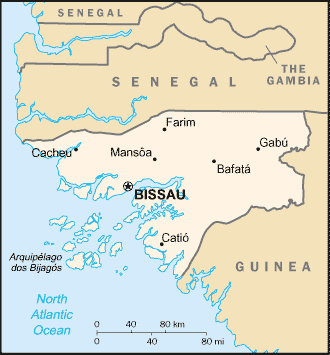Geography of Guinea-Bissau
|
|
This article describes the geography of Guinea-Bissau.
- Location
- Western Africa, bordering the North Atlantic Ocean, between Guinea and Senegal
- Geographic coordinates
- Template:Coor dm
- Map references
- Africa
- Area
-
- Total: 36,120 km²
- Land: 28,000 km²
- Water: 8,120 km²
- Area--comparative
- Slightly less than three times the size of Connecticut
- Land boundaries
-
- Total: 724 km
- Border countries: Guinea 386 km, Senegal 338 km
- Coastline
- 350 km
- Maritime claims
-
- Exclusive economic zone: 200 nm (370.4 km)
- Territorial sea: 12 nm (22.2 km)
- Climate
- Tropical; generally hot and humid; monsoonal-type rainy season (June to November) with southwesterly winds; dry season (December to May) with northeasterly harmattan winds
- Terrain
- Mostly low coastal plain rising to savanna in east
- Elevation extremes
-
- Lowest point: Atlantic Ocean 0 m
- Highest point: Unnamed location in the northeast corner of the country 300 m
- Natural resources
- Fish, timber, phosphates, bauxite, unexploited deposits of petroleum
- Land use
-
- Arable land: 11%
- Permanent crops: 1%
- Permanent pastures: 38%
- Forests and woodland: 38%
- Other: 12% (1993 est.)
- Irrigated land
- 17 km² (1993 est.)
- Natural hazards
- Hot, dry, dusty harmattan haze may reduce visibility during dry season; brush fires
- Environment--current issues
- Deforestation; soil erosion; overgrazing; overfishing
- Environment--international agreements
-
- Party to: Biodiversity, Climate Change, Desertification, Endangered Species, Law of the Sea, Wetlands
- Signed, but not ratified: None of the selected agreements

